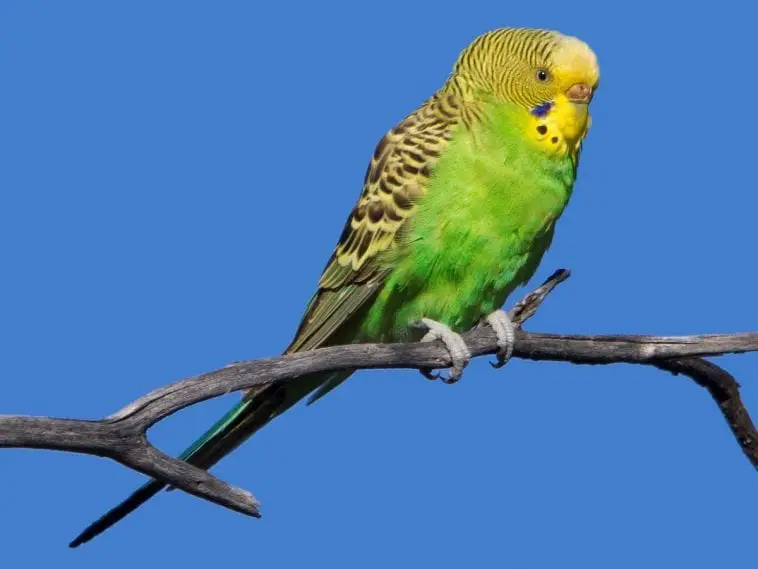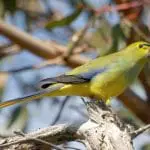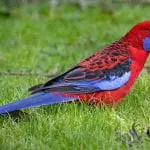Scientific Facts
| Common Name | Budgerigar, budgie, parakeet |
| Scientific Name | Melopsittacus undulatus |
| Life Span | 5 to 10 years |
| Size | 18 cm long, 30 to 40 grams in weight |
| Habitat | Dry areas |
| Country of Origin | Australia |
Physical Description
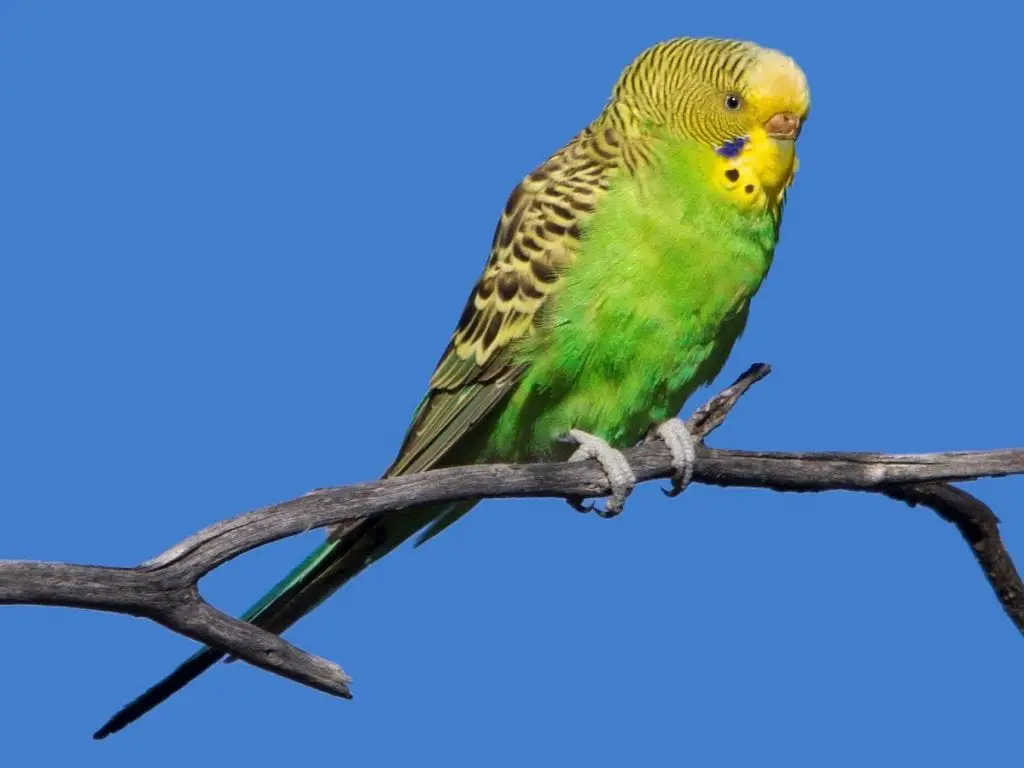
The budgerigar is also known as the American English parakeet and has a cute nickname budgie. It has a long tail colored green, yellow and black feathers and lovely markings on its nape, back, and its strong wings. These are bred in captivity with different colors like blue, white, grey, yellow, and small crests. When the budgerigar is in the hatchling and juvenile form, it is monomorphic, but as they become adults, you can already tell the males and females apart by their color and behavior.
The name budgerigar has mysterious origins. The species was first recorded in 1805, and soon afterward, it became one of the most popular pets around the world. Pet owners love the budgerigar for its small, compact size, low-cost care, and their impressive ability to mimic human sounds and speech. During that time, this bird became the third most popular pet in the world, third only to the domesticated cat and dog.
In the wild budgerigars are nomadic, live in flocks that move from one place to another in search of food. These birds have been bred in captivity from the 19th century. And whether budgerigars breed in the wild or in captivity, these breed in an opportunistic manner and in pairs.
Wild budgerigars are small with an average 18 cm length and weigh only 30 to 40 grams. They have a 12-inch wingspan and have a light green body coloration, especially along its abdomen and backs. Their mantles are pitch black with mantle markings with edged yellow undulations.
An adult budgerigar has a yellow forehead and face. Before the bird develops its adult feathers, juveniles have blackish marks down their noses until 3 to 4 months. There are small, blue-violet patches on the cheeks and three black spots on each side of the bird’s throat. The two throat spots are found at the outermost base of each cheek patch.
The tail has a cobalt blue color, while the outside features have a central yellow part. The wings have greenish-black flight plumage and black parts with yellow fringes together with the central yellow parts. These lovely colors are only visible when the bird is in flight or when the bird has outstretched its wings. Finally, the bills are olive-grey, while the legs are bluish-grey with toes that are zygodactyl.
In their natural habitat in Australia, the budgerigars are smaller compared to those in captivity. This parrot species is one of the most popular among breeders as they develop parrots with different colors and color shades. You will find grey, blue, grey-green, white, violet, pieds, and yellow-blue. The most common colors sold in pet stores are green, blue, or yellow. And just like most of the species of parrots, the feathers have a fluorescent glow when placed under ultraviolet light. This is a phenomenon that’s thought to be related to mate selection and courtship.
The upper portion of the beak is bigger or taller compared to the bottom part. The upper half covers the bottom part of the beak when the mouth is closed. The beak cannot protrude because of the thick and fluffy feathers around the mouth. The upper half of the beak is a smooth and long cover. This unique design of the beak allows the birds to eat all kinds of fruits, plants, and vegetables.
The budgerigar has a cere that differs in color in males and females. Males have royal blue, while females have pale brown to whitish. For immature males and females, this area is purplish-pink. Females may develop brown cere colors during breeding, and then after breeding, it will return to its natural color. Experts identify females using a very faint, chalk-like whiteness that starts near the nostrils. Males could be albino, dark-eyed, lutino, or recessive pied will retain the purplish-pink cere for the rest of their lives.
Identifying gender is easy using color, head shape, and behavior. On the other hand, vets determine the gender of the parrots through the examination of the bird’s blood, eggshell, and feathers.
Mature male budgerigars have light to dark blue cere, while in some mutations, it can be purple/pink. This includes the dark-eyed clears, inos, and Danish pieds. These types of budgerigars shave smaller or flattened back area if the heads. The females are very dominant and are intolerant of social interactions. Meanwhile, males are extroverted, cheerful, flirtatious, and very vocal.
Budgerigars have a tetrachromatic color vision. When exposed to ultraviolet light, their feathers become brighter to attract mates. The throat spots also reflect UV and are often used to distinguish different birds.
Color mutations
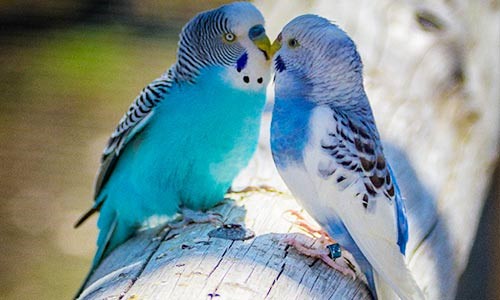
You can’t talk about budgies without mentioning its fantastic color range! Wild budgerigars have the yellow, green and black combination. Meanwhile, captive budgies come in two basic series of colors: white-based and yellow-based.
The white-based colors are blue, grey, and white, while the yellow-based are green, yellow, and grey-green. There are currently 32 primary mutations, even a violet color mutation. These 32 mutations open the breeder to hundreds more secondary mutations with stable-combined primary mutations plus color varieties or unstable color mutations.
When you ask budgie lovers, they would still prefer the good-old yellow-green-black bird while some say that the blue and white color is the loveliest. And because of the fantastic array of colors available, this bird has become the favorite for events with a color theme. It’s expected that more and more unique color combinations will be available, as well.
Budgerigar status
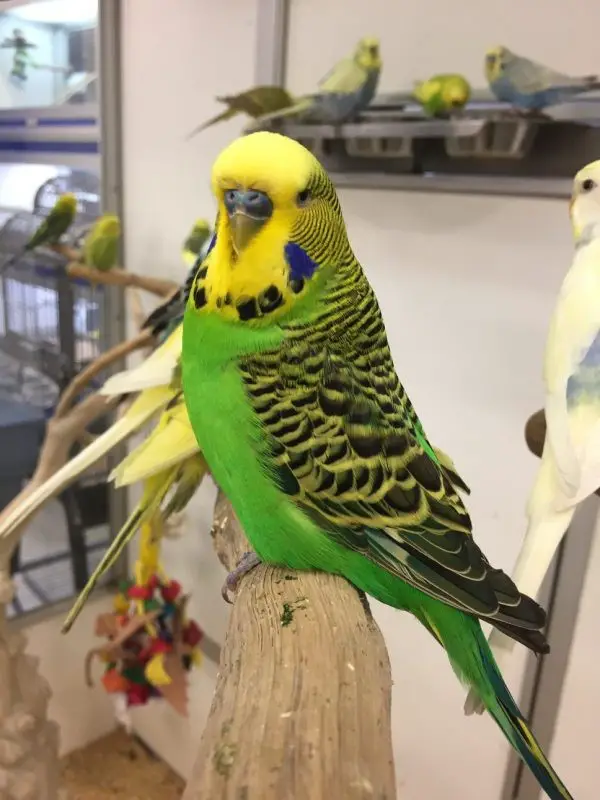
The budgerigar is listed as a least concern species under the IUCN. But people who support the breed say that capture of this species in the wild as well as the destruction of their natural environment must be stopped as early as possible to avoid diminishing the wild population of parakeets.
Budgerigar and human relations
Budgies have been bred in captivity since 1850. Breeders have created a variety of colors, patterns, and feather mutations such as blue, albino, cinnamon-ino, clearwing, dark, crested, grey winged, pieds, opaline, violet, spangled and dilute.
Meanwhile, English budgerigars are also called show or exhibition bids are twice the size of their wild cousins. These have puffier heads, which make them look bolder and sometimes scarier. The eyes and the beak may even appear to be absent as these are already hidden by the thick and fluffy face feathers.
The English budgerigars are more expensive than wild birds and have a shorter lifespan of 7 to 9 years. These lovely birds are mostly presented in shows and are sold to collectors.
Budgerigars are social birds and need constant stimulation using toys and human interactions or socialization with other budgerigars. Meanwhile, females are very active and persistent, as these can chew on wood. When this bird feels threatened, it will perch on the highest branch and will bring its lovely feathers closes to its body so it will look thinner.
Captive budgerigars can speak, whistle, and will play with humans when handled well. Males and females can mimic words and sounds and to perform simple tricks. But males are known to be better at mimicking and singing than females. Female budgerigars are rarely able to speak more than 12 words; on the other hand, males can have up to 100 words or more. Male pets that are kept alone are known to be the best in speaking human words. More on the different abilities of the budgerigar in the following sections.
Lifespan
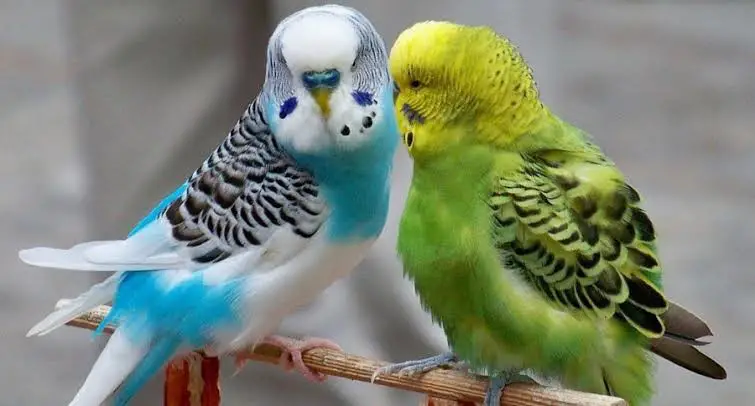
The budgerigar can live up to 8 years in captivity, although there are some breeders that have reported up to 20 years’ lifespan. Take note that the lifespan of this bird depends on the lineage, breed, and the overall state of health of the birds. Those that eat a healthy diet and exercise well tend to live longer. Also, being with humans and interacting with their owners on a regular basis can help the birds live longer, happier, and healthier lives.
Natural Habitat
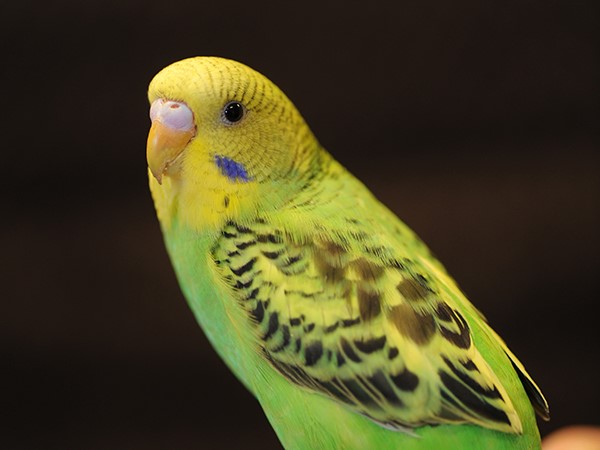
The budgerigar is a nomadic bird that moves from one area to another in groups. They are driven to different areas because of the ever-changing environmental conditions. These birds are native in open areas such as scrublands, open woodlands, and vast grasslands of Australia.
Budgerigars are commonly found in small groups but can become larger when conditions become favorable. The movement is closely related to the availability of water and food as drought can drive large flocks of budgerigars to coastal areas and wooded habitats. These birds are often seen feeding on grass seeds, spinifex, and wheat.
In areas outside Australia, budgerigars are also found in St. Petersburg, Florida. This area is where other birds nest like the house sparrows, European starlings, and so many more. Also, the warm, year-round climate in Florida has stopped the nomadic behavior of budgerigars in the area.
Perception and Communication
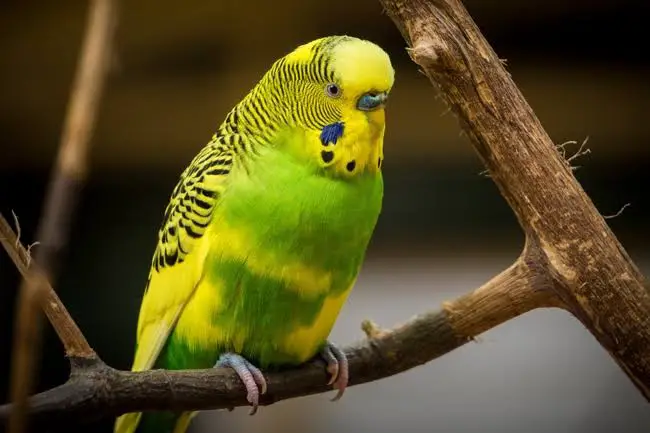
Male budgerigars are one of the top-five talking birds in parrots together with the grey parrot, amazon and Eclectus parrots, and the ring-necked parakeets. One of the most impressive budgerigars is a bird named Puck. This bird had 1728 words in his vocabulary and was included in the 1995 edition of the Guinness World Records.
Still, another impressive specimen is budgerigar is a bird named Victor. In 2001, his owner said that Victor can engage in contextual conversation and may even predict the future. Some also believed that the animal was able to predict its death. As of today, the recordings made by Victor are still being analyzed. Meanwhile, some critics argued that Victor’s speech was not as coherent to be considered as spoken in context.
Pet budgerigars still continue to shine, especially on the web. A bird named Disco is the star of many videos where he was seen talking all kinds of phrases. His most popular is “I am not a crook” and a long one that said, “Nobody puts baby bird in a corner!” Sadly, Disco died in 2017 because of an undiagnosed illness.
Behavior
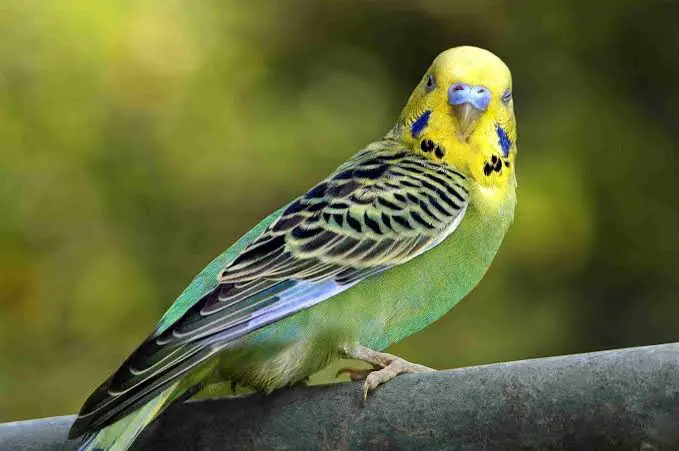
Budgerigars are known for the following behaviors
Social birds
Budgerigars are social birds and can be seen in groups eating, foraging, and flying as they look for new sites to stay. But during breeding time, these birds will remain with their partners until the new babies have hatched. Because of their social behavior, it’s a good idea to have at least three or four birds in a cage.
Need constant stimulation
These birds are very smart and need regular stimulation using toys and cage furniture. These also require stimulation from their owners, other birds, and even from other pets. It is said that birds that get constant stimulation from their owners can live fruitful, healthy, and long lives.
Threatened behaviors
Budgerigars are smaller than other birds and other animals, and hence they come up with survival behavior to help theme escape threats. What they do is the fly to the highest perk or bark of a tree and make themselves smaller. Their size allows them to hide from predators effectively.
Mimicry
Male budgerigars are known to have an extensive vocabulary compared to females who know only around 12 words. Aside from human speech, these birds can also mimic sounds, songs, and whistles. When you spend more time training your pet budgie, you will eventually find out that they can mimic different words that you speak even how you sound.
Chewers
The problem with budgerigars, especially female birds, is that they are strong chewers. These birds will chew on wood, plastic, and other materials to sharpen their beaks. To prevent this, give them mineral blocks, cuttlebone, and any softwood pieces. Cuttlebone contains calcium, which is important in making bones strong and in forming eggs.
Preening and feeding
Preening and feeding are affectionate behaviors. Bungies will feed each other and themselves. They will regurgitate the food to their flockmate’s mouth.
Females will never leave her nest
A female bird will lay her eggs every other day, and after the first one, there will be a two-day gap till the next egg. Females are very attached to her eggs, and she will only leave the nest to defecate, eat a little, and to stretch. She will remain in the nest watching over her eggs until these hatches, which is 9 to 15 days later.
No entry for males
Females won’t leave the nest, and she won’t let a male enter it as well. The only way a male will be able to enter the nest is when he forces himself in.
Will eat their own eggs
Sometimes, the parents will feel insecure inside the nest, and what they do to remove their stress is to eat their eggs. If you notice this behavior in your females, remove it from the nest or take the egg out of the nest instead.
Food and Diet
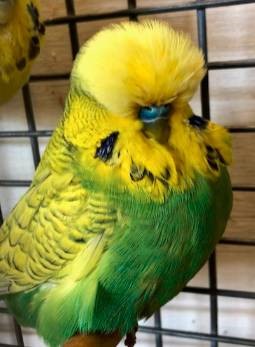
Budgerigars are herbivores; therefore, their natural diet is composed of seeds, fruits, nuts, and other kinds of green food. Just like other parrots, this bird will eat mineral-rich clay needed for protection against toxins that may be present in their diets.
In captivity, the Budgerigar will eat commercially-prepared seed mixes with sunflower, oats, safflower, millets, and hemp seeds. You may also feed your pets fresh fruits, dried berries, vegetables, pine nuts, and other organic food.
Captive parakeets will also require mineral supplements needed before and after the breeding season. The most important nutrient is calcium for bone health and egg health. You may also try “super-seeds,” which are hemp seeds. These contain complete amino-acids, omega 3 and 6 fatty acids and trace minerals. This also contains high amounts of protein, which is important for good health and development.
Environment and Housing
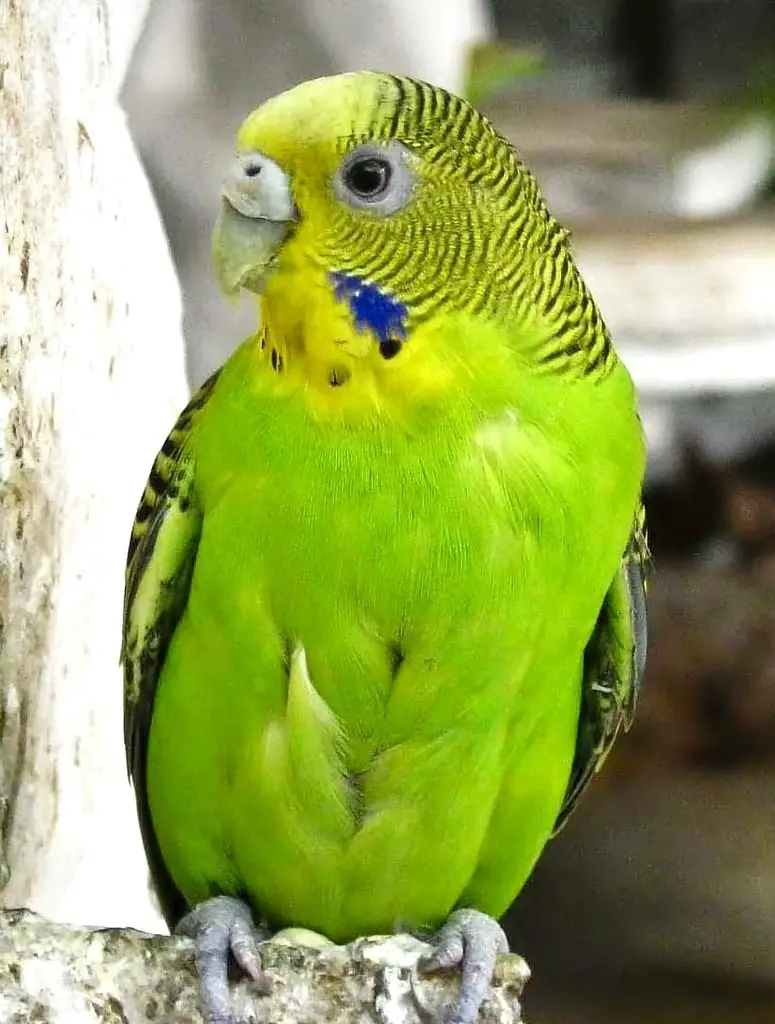
Budgerigars are small but require companions, so you must keep them in a large cage or enclosure. Select a spacious cage made of metal because budgerigars can chew on wood. The door must be secured with a lock, and this must be closed all the time.
This bird needs branches where it can perch. Choose natural plants where it can stay or sleep. As much as possible, select trees common from its natural environment. You may also use swings, ropes, artificial perches, mirrors, and posts where your pets can stay inside their large cage.
The Budgerigar will need a water basin and food container. The container must have a wide mouth so that the bird can easily eat its food. The cage must be away from direct sunlight and rain.
And if you’re considering getting two or more Budgerigars, use a large cage or enclosure which you can have custom-built. Place bedding of coconut husks, bark, or wood shavings. These materials are more popular because these absorb urine and are easy to remove when cleaning the cage. Other materials to use are old newspapers, paper towels, or brown paper.
When cleaning the birdcage, remove the bird and let it stay in a secure area; you may use a separate cage to house it for the meantime or until you’re done with cleaning the cage.
Hose the cage down, clean food and water containers. Use a natural cleaning product with disinfectant properties to deal with dirt and smell. And if you have installed natural trees and plants inside the cage, remove felled or dry leaves, and care for the tree or plant as you maintain the cage. You may place the bird back in the cage when everything is dry.
Health and Common Issues
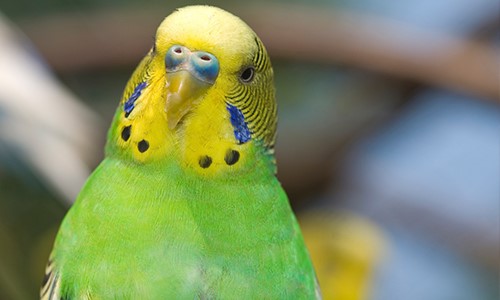
The Budgerigar is a healthy and hardy breed but may also suffer from common health issues.
Pacheco’s disease in birds
Pacheco’s disease is a fatal viral infection due to a type of herpes virus. The infected bird may spread this disease through contact with infected droppings and discharge coming from the nose or the mouth of birds. The virus may be dormant inside the bird and activated if the bird is in stress.
Stress can be due to a number of situations like moving, the death of a mate, and breeding. Symptoms of this disease are sinusitis, lethargy, tremors, anorexia, green-colored droppings, and death. You can prevent the spread of Pacheco’s disease by placing a new bird under quarantine, and to avoid handling a sick bird, use gloves and mask to avoid the spread of this condition.
Avian polyomavirus in birds
Avian polyomavirus is an infectious disease that affects mammals and birds. This is a deadly disease that affects young birds and passed on to other birds through droppings and handling infected birds.
Common symptoms of avian polyomavirus are weight loss, poor appetite, vomiting, swollen abdomen, diarrhea, and dehydration. To avoid this deadly disease, have your pet vaccinated against avian polyomavirus. You must have this checked right away because this may be spread to humans.
Giardia in birds
This is a parasitic infection passed on from one infected bird to another through cysts which are present in the feces of birds. The most common cause of giardia is unclean water supply. Symptoms of this You must take your bird to the vet as soon as you notice these symptoms. Giardia may affect humans if their water supply is the same as the contaminated water supply of their pet birds.
Malnutrition
Birds with an imbalanced diet or those that don’t get nutrients from their diet may suffer from malnutrition. Any of the illnesses mentioned may also contribute to malnutrition. Signs of malnutrition could be lack of energy, poor appetite, feather stress bars, and dark feather colors.
To avoid malnutrition, always make sure that your bird is getting enough sunlight, especially when their cage is indoors. Use artificial birdcage lighting when needed. Be very careful in changing the bird’s diet. Most of the time, birds will refuse to eat new food and may starve themselves. If this happens, take your pet to the vet after a change in diet.
Bird fever or psittacosis in birds
Bird fever is an infectious disease that is very common in almost all species of birds. This condition is spread through contact with the droppings of infected specimens. Common symptoms are difficulty in breathing, watery and green droppings, discharge from the eyes and nose, poor appetite, and poor energy.
Bird fever as soon as possible, and since this is contagious to humans, pet owners must wear proper protective equipment when caring for their pets, especially when they are cleaning their pet cages.
Other bird symptoms
And aside from the five common health conditions, be mindful of symptoms such as any strange appearance or stance, excessive plucking of feathers, poor balance, hanging from its beak, changes in behavior or attitude, trembling, walking in circles, and other very noticeable physical changes.
Also, any change in its droppings, breathing, eating, head appearance, feathers, legs, and feet should be cause for alarm. Consult your vet right away.
Preventive Care
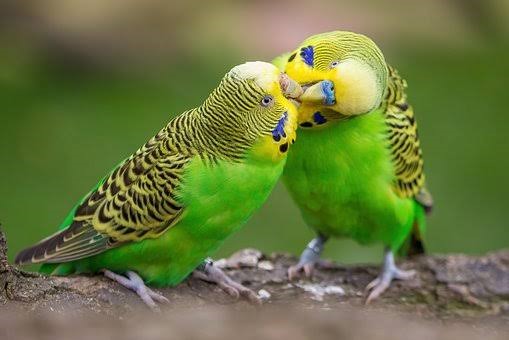
A budgerigar should undergo a complete physical examination every 6 months. Visit an avian veterinarian for the best care. An avian vet is an expert when it comes to dealing with bird conditions and illnesses.
And if you have any questions about the health of your bird, an avian vet can help you out. And if this kind of vet is not available in your area, consult a regular vet and ask for a recommendation.
Pet birds must go be subjected to annual fecal examination for yeast, parasites, and bacteria infestation. Your vet will provide vaccination for polyomavirus and routine blood testing to ensure that your pet is negative for these health conditions.
Birds must also have nail and wing trimming once or twice a year. An avian vet can help get these done for you. As a bird owner, create a routine to keep your pet’s surroundings clean.
You must clean your bird’s cage regularly. Get rid of droppings and thoroughly wash the cage with a safe cleaning product and water. Clean the feeding and drinking dishes and all the toys and cage furniture. All these will prevent the spread of illnesses and other health conditions.
Breeding in the wild and in captivity
In the wild, breeding of budgies happens from June to September in the northern parts of Australia and between August and January along the south. Budgerigars are opportunistic breeders, which means that they will only breed when the time is right. Usually, they will sense its breeding time when rains and grass seeds are more abundant.
Budgerigars have a unique way to show their affection to their flock-mates, and this is by preening. This is an activity where the birds feed one another. Budgerigar feeds each other by eating the seeds and by regurgitating the partially-digested seeds into another bird’s mouth. It is said that because of this, Budgerigars are more social, affectionate, and trusting with one another.
Budgerigar nests are made from holes in trees, logs, or fence posts. The female lays four to six eggs, which hare incubated up to 21 days. The eggs are one to two centimeters long and have pearl-white color if the egg is fertile. Females can lay eggs even without their partners, but these are unfertilized eggs and thus will never hatch.
Females have a white-tan cere, but when laying eggs, this turns to a crusty brown. There are females that may retain their white-tan cere while some retain the brown color. A female lays eggs alternately with a two-day gap.
The female lays 4 to 8 eggs. Each egg will be incubated for 21 days. Female budgies are very dedicated parents in such a way that it won’t leave her nests after the eggs have been laid. She will only leave the nest to defecate, feed a little and stretch but will come back to guard it. Usually, it’s the male who brings her food. He will visit her and just stays in the nest entrance to give her some food. Also, females will never let males inside the nest, but he may do so when he forces his way to the nest.
Experts say that some budgerigar males will not be interested in breeding with the opposite sex. These males will not reproduce and when together in a flock. To regain their interest, house a pair together in a cage where they can hear and see each other to start breeding.
Budgies suffer from breeding problems because of a number of reasons. Some chicks could die because of attacks inflicted by adults. Females can fight over a nestbox, and this can also contribute to problems with breeding.
There are also several health conditions that may affect the survival of the newborn Budgie. One condition is that the bird’s bills are under-lapped, where the lower mandible is on the upper mandible. A splay leg is another common problem. One of the legs is bent outward, which prevents it from standing correctly. Having a splay leg can affect a chick’s ability to compete for food and can also affect its ability to mate.
Still, some issues are genetic and are due to breeding inactive, ill, and related birds. Budgies that are related or those that have fatty tumors or other genetic issues should not be allowed to breed.
Place safe bedding and protect the chicks in the nest by adding a small amount of bedding inside the nest box. The box should be properly cleaned to prevent the accumulation of bacteria and other parasites. Place paper inside the box to prevent the female by chewing into the bedding and into the nest box.
Budgerigar development
The eggs of this lovely species can take up to 20 days to hatch. The babies are blind, naked, and completely helpless when they come out of the egg. Because of this, their mother feeds them and warms them up. She won’t leave her nest until every chick is ready to move out of it as well.
On day 10, the chicks will open their eyes and will begin to grow downy feathers. This is also when the closed banding appears. These band rings should not be larger or smaller than 4.0 to 4.2 mm. At three weeks of age, the chicks’ downy feathers will be replaced with real feathers. This is the best time to note the color mutation of the different birds. It is also the time when the male is able to enter the nest for the first time to help the female feed and care for their babies. However, it is also possible for a budgerigar female to completely forbid the male from entering the nest and decides to take care of her babies alone.
When breeding in captivity, it’s best to transfer a few hatchlings to another pair if the clutch size is large. A foster budgie parent must already be rearing their own hatchlings. You can do this earlier, though, while the chicks are still incubating inside their eggs as long as the foster parents are also incubating their own clutch of eggs.
As the chicks start to grow feathers, their ability to stay inside the nest safely increases. The mother bird can now leave her babies for a longer time. The babies will try to stretch their wings and assess their strength before they start to fly. Also, at this stage, the babies have developed the ability to shriek loudly and thus are able to defend their nests from enemies.
Young budgies leave the nest in the fifth week and are completely weaned from the nest and their parents from six to eight weeks of age. The time when the chicks leave the nest may depend on the size of the clutch, the number of surviving chicks, and the state of health of the surviving chicks. The oldest chick leaves the nest first, and the youngest is the last one to fledge. If the nest has only one surviving chick, this leaves the nest very early because it has benefited a lot from the full attention and care of his parents. Meanwhile, captive, owner-reared chicks can take more time to wean compared to those raised by their parents. Hand-feeding is not possible because of their small size, and parent-trained chicks can easily be tamed by humans.
Availability – Where to Get One?
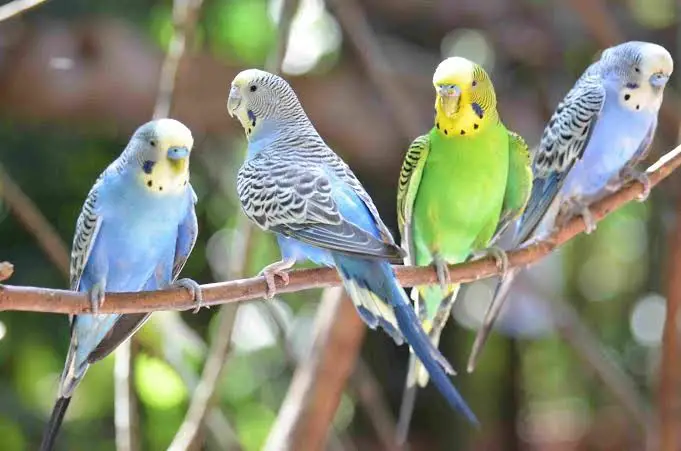
Budgerigars are usually available for sale from a breeder, or from an avian pet store that specializes in pet birds. You can purchase these from an online pet shop. The price for a Budgerigar online is from $30 to $50 depending on the gender, age, and appearance of the bird. Usually, the shipping and delivery costs can greatly increase the costs of buying a budgie online or offline.
But why buy when you can adopt? Aside from dogs and cats, budgerigars and other exotic birds are available for adoption from bird adoption or rescue organizations. These institutions help birds find new and loving families and homes.
How to Care for a Budgerigar
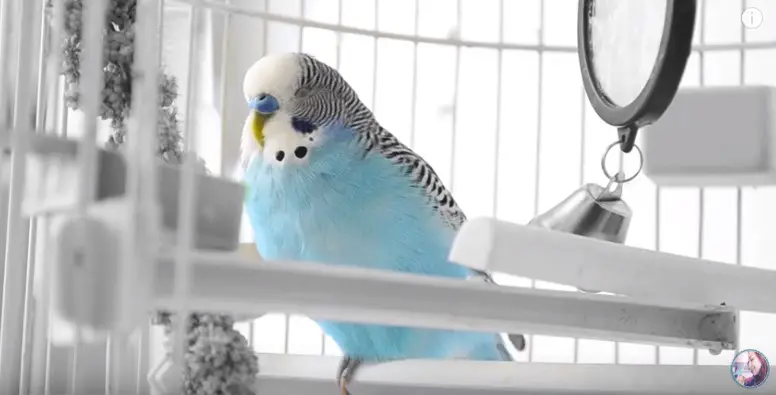
Budgerigars have distinct needs and have unique personalities. Aside from medical attention, feeding, and training, you should be willing to commit to four hours a day of cage maintenance, feeding, and interaction. Don’t overlook caring for your pet because doing so will maintain your pet’s mental and physical condition.
House your pet in a large-sized cage that’s comfortable and secure. The cage must be big enough for your pet birds. And it should be able to spread his wings without contacting the cage bars. Place natural branch perches and toys like mirrors, balls, swings, poles, and perches. These toys can help stimulate your pet’s mental and physical wellbeing.
And of course, hold your pet regularly to create a close bond between you and your pet. You must learn how to handle it with care or if you want to place it on your arm and shoulders. Because even if the bird’s claws are small, these can also inflict pain. Also, teach other people in your home how to correctly handle your budgerigar. Remember to do this in an enclosed or indoor area in case your bird tries to fly away; you may still catch it.
And when it comes to feeding, give it appropriate bird food. You may feed it commercially-prepared food. For and vegetables, organic produce is always the best. Create a fixed feeding schedule and don’t feed too much to avoid. Keep a bowl with clean water inside the cage, and make sure to keep this fresh, change this twice daily.
Budgerigars will love petting and stroking. Some pet owners say that their birds can respond to their names. Some also say that you can teach it some tricks, but take note that the safety of your pet is foremost. You may allow someone new to handling a very small bird like the budgie holds your pet but do so with your supervision.
FAQs
Can budgerigars eat fruits and veggies?
Yes, they may eat fruits and veggies as long as these are cut into very tiny pieces. You may try feeding your pet pureed food, like baby food, like pureed apples, bananas, and other fruits.
Will budgerigars drink water?
Yes, these birds need water and will readily drink from a small bowl. Despite the size of a budgerigar, the water bowl should be made of heavy material like clay so the birds can drink from it without spilling the contents.
How often do you feed your pet budgerigar?
You can place fresh seeds, pureed fruits, and veggie slices inside their cage in the morning and replace their water as well. Designate daily feeding time so they will know when to expect you every day.
Do budgerigars feed their young?
Yes, budgerigar parents will stay after the chicks hatch until they develop feathers. Parents bring their chicks all kinds of food and then drop this inside their largemouths.
Why do budgerigars feed their cagemates?
Preening is when a bird feeds other birds, but budgerigars also feed other birds inside their cage, not their offspring. This is a sign of affection and bonding and is most common in partner budgerigars while the female remains inside the nest, and the male feeds her.
How long will a budgerigar live without food?
Captive budgerigars need to be fed once a day, and they rarely go hungry in the wild. It would be safe to say that these birds may only go a day without food.
What to do when your pet budgerigar is not eating?
If you notice that your pet budgerigar is not eating, assess for other symptoms like diarrhea, lethargy, and feather changes. Take it to the vet.
What to do if your pet budgerigars are not drinking?
Birds can suffer from dehydration if they don’t drink, so if you notice that your pet is not drinking, change the water in the dish or offer fresh fruits and veggies instead. If it still remains this way, consult a vet.
How to introduce new food to a budgerigar?
New food can be stressful, so offer it together with the new food. New commercial bird food is the usual problem, so before the old one runs out, feed it the old and new brand and slowly wean it from the old brand.
How to get a budgerigar to eat from the palm of my hand?
You can place his favorite food in your hand or use the technique that zoos do. They place some pureed fruit and nuts on one end of a stick and allow the bird to eat from this. Slowly take the stick to your hand and slide the food, and the bird, to your palm.
How large should the cage of a budgerigar be?
The cage must be large enough for a bird to stretch its wings and not touch the walls of the cage. More budgerigars mean you need a larger cage.
Where is the best place to place a birdcage?
You can place the birdcage indoors, but it must be near the window but far from moisture. You can also place the birdcage on the porch or at the yard, but it must be away from direct sunlight and should be very secure from predators like cats.
What is the best cage furniture for budgerigars?
Add swings, perches, mirrors, hoops, and balls. Make sure that these are made of safe materials and won’t be easily chewed on. Budgerigars love to chew.
Can you place a real live plant inside a budgerigar cage?
Yes, you can as long as you care for it as well. Remove dried and fallen leaves and bark. Water the plants daily as well.
Can you place a radio near the budgerigar cage?
Yes, you can but place the volume in an audible setting but not too loud.
Can you leave a male and female inside a budgerigar cage?
Yes, you can leave a pair in a cage as long as the cage is large enough to fit two or more birds comfortably.
How do you teach a budgerigar to speak?
By daily talking to your pet and interacting with it, you will be able to teach it simple words.
What is the best gender for budgerigars when teaching the bird to talk or mimic speech?
Males are known to be capable of learning more than 100 words, and single males are the best to mimic human speech and noise.
Can a budgerigar whistle?
Yes, it can also mimic a whistle, even distinct whistling sounds, since your whistle is different from other members of the family.
How do you teach a budgerigar to follow commands?
You can teach your pet budgerigar to follow commands by using treats. Use the treat on a stick method and simply guide the bird to the command. Don’t overdo this; give your pet time to rest before doing the trick again.
How much time do you need to teach a budgerigar to speak?
It can take weeks to teach a few words. Just talk to your bird a lot with simple words, over and over again. If your pet is able to mimic the sound of the postman saying “mail” every time he drops off your mail, then you can also teach him different words.
How many eggs does a budgerigar lay?
A female budgerigar can lay up to 5 eggs with each egg having a few days in between. This is why you can easily designate who is the oldest and the youngest chick in the clutch.
Can female budgerigars eat their own eggs?
Yes, this has been observed, and experts still don’t know why this happens, but some say that the parent feels insecure in the nest/
How long before a budgerigar chick leaves its nest?
It can take six to eight weeks before budgerigar chicks leave the nest, and usually, the oldest chick leaves the soonest, and the youngest or the weakest chick leaves last.
Can you take the eggs of a wild budgerigar and hatch it?
Yes, you can remove the eggs of a wild budgerigar and take it home to hatch it, but you must provide almost the same environment for the eggs to stay warm and safe. Use a warm lamp to incubate the eggs and place layers of thick cloth around it to keep it warm and dry; in a few days, it will hatch baby budgerigars that are naked, blind, and helpless.
Are budgerigars good parents?
Yes, budgerigars are good parents in such a way that the mothers stay in the cage for many weeks without leaving to care for and feed their young. The father also chips in by foraging for food and feeding this to his offspring. The parents will remain in the nest until the young are able to grow feathers and fly away.

